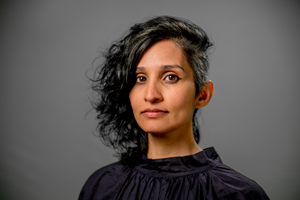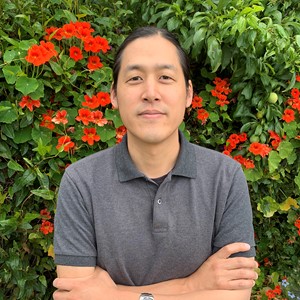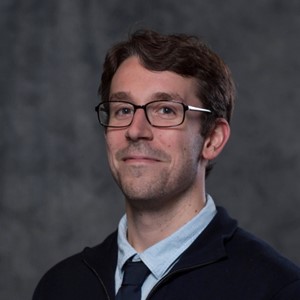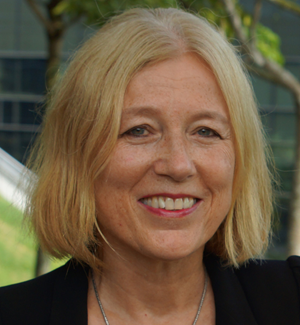Art, Science, and the Stories We Tell About Technology
Session Description:
We understand computer graphics as both a mathematical and visual language. The development of the tools and methods we use in computer graphics are often hidden, or from the surface, appear to be invisible. How do we construct narratives around these complex histories? And what are the methods for carrying out this research? This session presents unique perspectives on some of these histories.
Session Day and Time: 19 October 9:15am-11:00am
Length: 90-110 minutes
Format: Individual talks
Chair Bio:

Raqi Syed (Sr. Lecturer, Te Herenga Waka | VUW, School of Design Innovation)
Raqi Syed is a writer, visual effects designer, and researcher. She is co-director of the award-winning film experience MINIMUM MASS and has worked on a number of films for Disney Animation Studios and Weta Digital. Raqi is the Programme Director for the Master of Design Technology at VUW School of Design Innovation. Her practice and teaching focus on the materiality of light, hybrid forms of non-fiction and genre storytelling, and using media archaeology and software studies methodologies to better understand contemporary practices in visual effects.

Theodore Kim: Associate Professor, Yale University, Department of Computer Science
Theodore Kim is an Associate Professor in Computer Science at Yale University, where he investigates biomechanical solids and fluid dynamics. Previously, he was a Senior Research Scientist at Pixar. He is the recipient of a Scientific and Technical Academy Award, and his algorithms have appeared in over 20 films.
Should Art Inspire Technology?
The technical limitations of early CGI in movies forced filmmakers to get creative. Working within these constraints yielded the enduring image of the liquid metal T-1000 in "Terminator 2: Judgement Day", as well as the plastic spaceman Buzz Lightyear in "Toy Story". What about the other direction, when "art challenges the technology", or more pointedly "commerce drives the technology"? The results can be unpleasant, as I will discuss in this talk.

James W. Malazita: Assistant Professor, Rensselaer Polytechnic, Department of Science & Technology
James Malazita is an Assistant Professor in the Department of Science & Technology Studies (STS) at Rensselaer Polytechnic, with an appointment in the Program in Games & Simulation Arts & Sciences (GSAS). He is also the founder of the Tactical Humanities Lab @ RPI. His current work looks at the politics of game engines and their impact on design, the synthesis of humanistic and computer science education, and histories and epistemologies of design.
The White Fantasy of Being Physically Real: The Intertwining of the Machine, Race, and Ontology in Realtime Physically Based Rendering
Physically based rendering (PBR) practices are becoming a new dominant realtime graphical pipeline standard, with prominent games and visualization softwares like Unreal and Unity adopting the technique as their default shading model. PBR promises both a more streamlined shading experience for digital artists and also more physically real, immersive realtime graphics. As such, PBR promises better looking, more efficient, and more truthful representations of the world.
However, PBR’s narrative is a fantasy, both in terms of its adherence to physical reality and its universality. Through a feminist science studies and critical race lens, this talk will explore the empirical and political assumptions built into both the physics behind and practices of PBR, and how these assumptions can impact technical and visual representations of Blackness. PBR, I argue, does not represent a universal physical world, but rather one that preferences white perspectives and vision.

Audrea Topps Harjo: COO, A44 Games & Founder of InclusionFX
Audrea Topps Harjo has worked in the entertainment industry for almost thirty years. She has worked for Sony Pictures (CONTACT) Rhythm and Hues, Electronic Arts, WETA Digital (RISE OF THE PLANETS OF THE APES), James Cameron’s Lightstorm Entertainment (AVATAR SEQUELS). She produced three independent films (SECRETS, ALL IN, THE AVAILABLE WIFE) She served as Mind & Machine’s VFX Producer on Ridley Scott’s (RAISED BY WOLVES). She is currently COO at A44 Games and founder of InclusionFX, which is a platform designed to support and amplify underrepresented voices in the VFX for features, television and games industries in Wellington, NZ.
Case Study: InclusionFX
InclusionFX is a platform designed to support and amplify underrepresented voices in the VFX/Game Industries. Our mission is to bring to light those “black unicorns” who had survived and thrived in an ever changing and challenging environment. Our goals are to inspire and give the next generation access to role models by sharing the “hero’s journey” of a diverse range of professionals. Being from a diverse background comes with its own set of challenges that we want the next wave to be prepared for. This talk explores the genesis for this project, key takeaways and why hearing the diverse perspectives of practitioners matters.

Vibeke Sørensen: Visiting Scholar, Center for Advanced Study in Behavioral Sciences (CASBS) at Stanford University
Vibeke Sorensen is an artist and professor working in digital multimedia and experimental animation, immersive multimedia, interactive architectural installation, and visual music. She was professor at Nanyang Technological University (NTU) Singapore from 2009- 2021, where she served as Chair (Head of School) of the School of Art, Design and Media (ADM) from 2009- 2019. She was founding director of the Computer Animation Lab at California Institute of the Arts (CalArts) from 1984-1994, and professor and founding Chair of the division of animation and digital arts (DADA), in the School of Cinematic Arts at the University of Southern California (USC) from 1994-2004. In 2007, she was the Chair of the ACM SIGGRAPH Art Gallery, Global Eyes. Sorensen’s research in new technologies has been supported by the National Science Foundation (NSF), the USC Annenberg Center for Communication, Intel Corporation and NTU Singapore. In 2020 her work on the colour music of the Balinese calendar was the focus of an exhibition by a team of architects, artists and researchers from ETH Zurich at the Sharjah Architecture Triennial. She is currently associate faculty at the Complexity Science Hub Vienna since May 2021, and Visiting Scholar in the Center for Advanced Study in the Behavioral Sciences (CASBS) at Stanford University. For more information, please see http://vibeke.info/about/
Experimental Digital Multimedia: Western and Non-Western Conceptions of Space-Time
This talk will introduce experimental electronic and digital multimedia artwork, which includes art and design that explores Western and Non-Western conceptions of space-time.
Illuminations (2013) is an interactive visual-music installation influenced by Asian folding screens that incorporates plant biofeedback, ubiquitous computing, and electro-acoustic music. Inspired by Indian textiles, symbols, and cosmologies, Mayur (2015), a 4K animation, and Vishwaroop (2014), is a generative dome animation that explores Asian spatiotemporal patterns and rhythms. Both of these works feature original music by sitar virtuoso Kartik Seshadri. Mood of the Planet (2015), is a Big Data work, a kinetic light-sound sculpture employing real-time social media data to detect the current “mood” of people at diverse locations around our planet. This led to In Other Wor(l)ds (2018), a series of large scale illuminated tapestries that feature textiles, embedded systems, networks and global environmental data. Inspired by the Chinese philosophy of Chi and Schoenberg’s quartet “I feel the air of a different planet”, In Other Wor(l)ds conveys the idea that the energy of the Universe is like the air that surrounds us, and the winds of other places move the fabrics that touch our bodies in the breeze. Digital Amulet: Smart Necklace (2017) incorporates 3D printing and wearable computing, with biofeedback and visual music for communication and meditation. The latest 2021 project, Star Light, is a scientific visualization of actual quantum data emanating from pulsars in an interactive architectural installation in collaboration with Stephen Lansing and Lock Yue Chew from Nanyang Technological University in Singapore.

